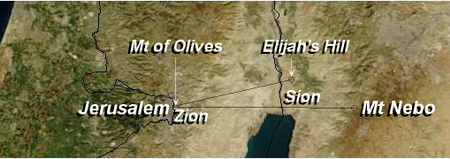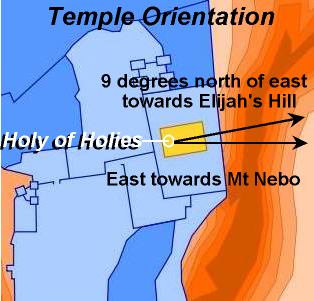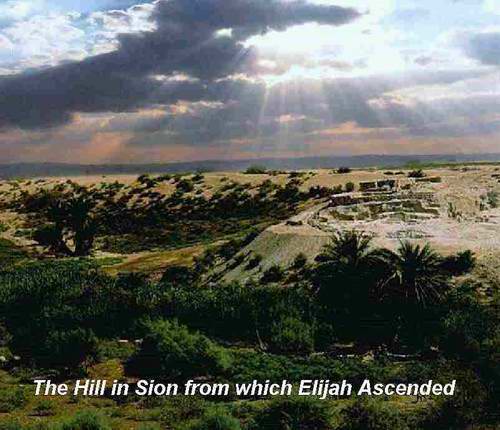|
|
From The Series Previous
Article The
Location of Mount Sion and Hermon The Place of Salvation?
Sion and Zion The Connection Psalm 133
Behold, how good and how pleasant it is for brethren to dwell together in unity! It is like the precious ointment upon the head, that ran down upon the beard, even Aaron's beard: that went down to the skirts of his garments; As the dew of Hermon, and as the dew that descended upon the mountains of Zion: for there the LORD commanded the blessing, even life for evermore. The rising moisture from the
region of Hermon in the hills of Sion, to the east, is caught by the prevailing
morning breezes and then falls on Jerusalem in the mountains of Zion as dew,
especially in the late summer and early fall. It is along this easterly to
westerly line between the Hill of Hermon, or Elijah's Hill, and Jerusalem that
the Lord commanded the blessing of life evermore.
David, who selected the location for Jerusalem and its future temple, was the author of this psalm and most other psalms in the scripture. According to Jerome's translation, and those of others, including the first edition of the King James Version, David was well aware of the difference between Zion and Sion. In texts of David's psalms from multiple centuries earlier than the King James Version, Sion appeared seventeen times and Zion appeared twenty times.[1] And David was well aware of the location of Hermon, or Elijah's Hill, in Sion. In his second psalm, according to these earlier texts, David wrote: Yet have I set my king upon my holy hill of Sion. As the architect of the first temple, David set its location west of Nebo. Yet he did not orient the temple towards Mount Nebo. In 1983 Biblical Archaeology Review published an article by Hebrew University professor Asher S. Kaufman in which he identified archeological points revealing that the first temple's centerline was oriented, from front to back, southwest by 9 degrees.[i] This also means that the centerline from the back where the Ark of the Covenant sat through the frontal court and out the Golden Gate was oriented northeast by 9 degrees. When that line is extended northeastward it passes over Elijah's Hill in the cleft of Pisgah through the hill country of Sion on the other side of the Jordan. The Hebrew word Sion is spelled quite differently than the Hebrew word Zion. Sion begins with the Hebrew letter shin and Zion begins with the letter tsade. In ancient languages, like the ancient Hebrew, each letter was a symbol with a meaning. When letters were combined to form words the individually combined symbols in their given order gave a richer and deeper meaning to the entire word. According to the Ancient Hebrew Research Center the letter tsade beginning the word Zion has a meaning of a trail to an intended goal while the letter shin beginning the word Sion has a meaning of again, second or two. Both of these Hebrew words end in the Hebrew letter nun. Nun symbolizes heir or continuing to a new generation. So it could be interpreted that Zion was the beginning of the trail for the second faithful called again to be the figurative spouse for a new generation emanating from Sion. In Eastern thought the term "face to face" primarily refers to the moment that the newly wed couple first viewed each other as the veil is lifted from the bride's face. Accordingly, there are biblical inferences that the two cherubim facing each other atop the ark in the Holy of Holies were masculine and feminine representations. (Exodus 25:20, 37:9) If so the line from Elijah's Hill in Sion through the central axis of the temple in Zion ended between these two glorious representations at the mercy seat.
Along this line beyond the Golden Gate to the east up on the Mount of Olives, as a hill on the ridge of Zion, stood the Miphkad Altar. It was here where the Red Heifer sacrifice took place. It was at this place that the ashes of the Red Heifer were daubed on the foreheads of the populace for ceremonial purifications reminding them that without regeneration by resurrection their end would be no more than ashes. This too was the spot where Jesus Christ gave his life on the cross. And nearby he was resurrected as the way, the truth and the life.[3] According to ancient Hebrew tradition, the entrance to Garden of Eden had once been at this place on the Mount of Olives so that the temple with its sacrificial rituals was positioned facing this former entrance. When Jesus made his final entry into Jerusalem less than 48 hours before before his crucifixion, he rode an ass with the colt of an ass down the Mount of Olvies along this line connecting the temple with Elijah's Hill. And when they drew nigh unto Jerusalem, and were come to Bethphage, unto the mount of Olives, then sent Jesus two disciples, Saying unto them, Go into the village over against you, and straightway ye shall find an ass tied, and a colt with her: loose them, and bring them unto me. And if any man say ought unto you, ye shall say, The Lord hath need of them; and straightway he will send them. All this was done, that it might be fulfilled which was spoken by the prophet, saying, Tell ye the daughter of Sion, Behold, thy King cometh unto thee, meek, and sitting upon an ass, and a colt the foal of an ass. And the disciples went, and did as Jesus commanded them, And brought the ass, and the colt, and put on them their clothes, and they set him thereon. And a very great multitude spread their garments in the way; others cut down branches from the trees, and strawed them in the way. And the multitudes that went before, and that followed, cried, saying, Hosanna to the Son of David: Blessed is he that cometh in the name of the Lord; Hosanna in the highest. Matthew 21:1-9 Here, like in numerous Old Testament prophecies regarding those in Zion, the men who might ask of the need for the ass and the colt of the ass were considered "daughters". Here Jesus addressed the potential inquisitors not only as daughters but additionally as daughters of "Sion." According to Eastern thought the soul was considered feminine whether that of a man or a woman. Definitions of the Greek word translated as daughters include female relatives or descendants. The definitions also include that of the inhabitants of an area or village dependent on a city. This statement and these definitions beg the questions; who then are the masculine relatives and on what city were the daughters dependent? The masculine relatives were and will be the Lord Jesus himself with the fullness of Christ embodied within and saints like Moses, Elijah, and David who were gifted from birth with their portion of the spirit of Christ.(John 3:34, I Peter 1:11) The location of the place on which the daughters of Sion were and will be dependent is within the phrase itself and in the book of Hebrews. In the phrase, the dependency of those in Zion was upon Sion. But what place has been in Sion? To name the more thematically significant, reoccurring in the cycles of time: 1) Melchisedec, king of Salem, priest of the most high God met Abraham; 2) Esau met Jacob who then bowed and called Esau Lord; 3) Moses commissioned Joshua in the cloud filled tabernacle and then disappeared from sight on Nebo; 4) Elijah commissioned Elisha to carry on what he had begun and then ascended in a whirlwind; 5) After arising from the waters of the Jordan in John's baptism, Jesus selected the first of those to become his foundational apostles; 6) Nearby, in the sight of Peter, James and John, Jesus Christ was gloriously transfigured together with the descended Moses and Elijah; 7) In this area to the east of the Jordan, then considered as part of Arabia, Paul spent 3 years in contemplation before beginning his ministry to reveal the great mystery of Christ and the church. All of these, and other events that occurred in the area, point towards the character of what will be in and what will come out of Sion upon the day of salvation. As the book of Hebrews states: But ye are come unto mount Sion, and unto the city of the living God, the heavenly Jerusalem, and to an innumerable company of angels, To the general assembly and church of the firstborn, which are written in heaven, and to God the Judge of all, and to the spirits of just men made perfect, And to Jesus the mediator of the new covenant, and to the blood of sprinkling, that speaketh better things than that of Abel. Hebrews 12:22-23 It appears that David wrote the 133rd Psalm with this in mind. Behold, how good and how pleasant it is for brethren to dwell together in unity! In the Hebrew the words together and unity are the same word. Those of the culture understood that this combination was a rhetorical figure of speech emphasizing the point made. The Hebrew word is yachad. One aspect of its meaning is for two things to be brought together in harmony. The Hebrew word for brethren is ach. It means one of the same tribe and has an aspect to its meaning of a reciprocal relationship. The word Hebrew word for dwell is yashab. Its meaning emphasizes a dwelling in marriage.[4] Jesus stressed the marriage relationship as a figure of his second coming. (Matthew 22:1-14, 25:1-13) Likewise Paul stressed the figure of the marriage relationship in his summary conclusion to his writing to both the saints with the spirit of Christ and faithful souls in Christ Jesus. (Ephesians 5:20-33) In the last verse David wrote: As the dew of Hermon, and as the dew that descended upon the mountains of Zion: for there the LORD commanded the blessing, even life for evermore. David knew the connection between Sion and Zion. When he was in Sion he saw the clouds ascend in the morning breeze and move west to drop their dew on Zion. Then when he was in Zion he felt the early morning dew as it descended on Jerusalem. He knew of the hill in Pisgah where great spiritual things came to pass in the history of Israel and would one day come to pass for all who will believe in the Lord Jesus Christ. And David designed the temple, containing the Ark of the Covenant, fashioned according to Moses' revelation, to point towards the Hill of Hermon, later known also as Elijah's Hill, that lay in Sion.
Jesus learned and fulfilled David's prophecies. It was between Sion and Zion where the most notable events in his ministry occurred. He was baptized and transfigured in Sion and he was crucified, raised and ascended in Zion. Zechariah also foreknew of the connection. He wrote of a very great valley of refuge that would open between Zion and Sion when the Lord would come again with all his saints. (Zechariah 14:4,5) And Paul foreknew likewise that this was the place to which those faithful to the Lord Jesus Christ would be delivered away from the wrath to come. (I Thessalonians 1:10, Hebrews 12:22) Peter who heard these figures and inferences from both Jesus and Paul about the fulfillment of things in the marriage wrote of the second coming of the Lord Jesus Christ as the completed realization of his temporary experience with John and James on the Mount of Transfiguration or, as he wrote, the holy mount. (2Peter 1:16-21) Upon the mount, the saints, Moses and Elijah, appeared with Jesus Christ in their glorified states to the daughters of Sion, Peter, James and John. Then a supernatural cloud enveloped Peter, James and John from which a voice came saying, "This is my beloved son, in whom I am well pleased; hear ye him." Next ArticleCaught Away Together In the Clouds of Sion The Betrothal and Marriage
Introduction and Main Index
[1] Sion usages in first edition of the King James Version that were changed to Zion in later editions. : Psalms: 2:6, 9:11, 14; 14:7; 20:2; 48:2, 11, 12; 50:2; 51:18; 53:6; 69:35, 74:2: 76:2; 78:68; 97:8. Jerome, who translated the Old Testament from much earlier texts of the Hebrew than the King James translators, translated all usages of the later King James translation "Zion" as "Sion". Jesus never used the word "Zion" nor did any New Testament authors but as the records show did speak or write of "Sion". [2] Where The Ancient Temple of Jerusalem Stood, Kaufman, A. S., Biblical Archaeology Review, March/April, 1983. pp. 41-59 [3] Secrets of Golgotha, The Lost History of Jesus Crucifixion, Martin, E. L., Associates for Scriptural Knowledge, Portland, 1996 [4] The New Strong's Expanded Exhaustive Concordance of the Bible, Stong, J., Thomas Nelson Publishers, Nashville, 2001 yachad #3162, ach #0251, yashab #03427 |


